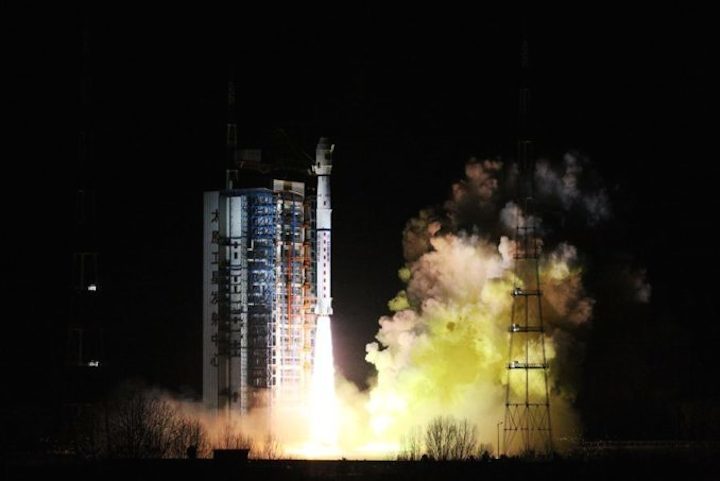
A Chinese Long March 4C rocket launched Tuesday with a new polar-orbiting weather observatory named Fengyun 3D, replacing an aging satellite for the China Meteorological Administration.
The Fengyun 3D satellite lifted off at 1835 GMT (12:35 p.m. EST) Tuesday from the Taiyuan space center in Shanxi province located in northeastern China.
A three-stage Long March 4C rocket boosted the approximately 2.5-ton satellite toward the south from Taiyuan, where launch occurred at 2:35 a.m. local time Wednesday
The Long March 4C’s three liquid-fueled stages placed the Fengyun 3D satellite in a 500-mile-high (800-kilometer) polar orbit tilted 98.7 degrees to the equator, according to tracking data released by the U.S. military.
Fengyun 3D hosts 10 instruments to collect data on atmospheric conditions, cloud and storm movements, ozone health and greenhouse gases, the China Meteorological Administration said in a statement announcing the successful launch.
The new satellite, designed for mission of eight years, “will help people learn about the future weather conditions earlier and reduce the economic and social impact of natural disasters,” CMA said in a statement. “Its ability to detect aerosols and greenhouse gases will play an active role in coping with climate change.”
Fengyun 3D will replace the Fengyun 3B weather satellite launched in November 2010. Another Chinese weather satellite already in orbit — Fengyun 3C — will conduct tandem observations with the newest member of the fleet.
Tuesday’s launch placed Fengyun 3D into an orbit that passes overhead in the afternoon. Fengyun 3C is in a mid-morning orbit, giving Chinese forecasters a snapshot of weather conditions twice a day.

China also has Fengyun 2-series satellites in higher geostationary orbits to collect near real-time imagery of storms and cyclones moving across the Asia-Pacific region.
The polar-orbiting observatories are designed to gather data inputs for numerical weather prediction models, which generate medium-range forecasts predicting changing weather conditions up to a week advance.
Fengyun 3D’s mission is comparable to that of U.S.-built JPSS 1 weather craft set for launch Wednesday to join NOAA polar-orbiting satellite fleet.
Ground controllers will guide Fengyun 3D into a slightly higher orbit in the coming weeks to begin regular weather observations.
One of Fengyun 3D’s instruments will take medium-resolution images with an upgraded camera that can see in 25 optical channels, 15 solar reflective channels and 10 infrared channels, allowing it to gather detailed data during day and night passes.
Other sensors will measure soil moisture content, probe temperature and humidity at multiple layers in the atmosphere, and detect greenhouse gases in the atmosphere, a major contributor to climate change. Another instrument will monitor the health of the ozone layer, and an auroral imager and ionospheric photometer track the effects of space weather and solar storms, Chinese officials said.
Fengyun 3D will be China’s first remote sensing satellite to transmit and receive data through Antarctic ground stations, allowing weather observations to more quickly reach forecasters. Ninety percent of Fengyun 3D’s observations will be transmitted back to China within 80 minutes, according to CMA.
A privately-developed piggyback payload lofted into space Tuesday aboard the Long March 4C rocket carries an AIS maritime tracking receiver. Named HEAD 1, the 100-pound (45-kilogram) microsatellite is the first spacecraft owned by Beijing-headquartered HEAD Aerospace, which aims to deploy a constellation of 30 small satellites in the next few years.
Tuesday’s launch marked China’s 12th orbital launch attempt of the year, and the 11th to successfully reach orbit.
Quelle: SN
+++
China launches Fengyun-3D weather satellite and private maritime microsatellite
China successfully launched the Fengyun-3D weather satellite into a polar orbit on Tuesday, along with the first satellite for private Chinese company Head Aerospace.
The Long March 4C rocket lifted off from Launch Complex 9 at Taiyuan Satellite Launch Centre in Shanxi Province at 18:35 UTC (02:35 November 15 local time), sending the Fengyun-3D towards a circular Sun-synchronous orbit at an altitude of over 800 km.
Fengyun-3D is the fourth satellite of the second generation of Chinese polar-orbiting meteorological satellites, carrying instruments for sounding, imaging, radiation and humidity, and detecting space weather.
The 2450 kg Fengyun-3D, with one solar panel mounted on one side of the satellite, will be operated by the China Meteorological Administration (CMA) and National Satellite Meteorological Centre (NSMC) and will help provide meteorological forecasts as well as contribute to ocean, ice and climate monitoring, and atmospheric chemistry and space weather studies.
A Long March-4C rocket launches Fengyun-3D weather satellite from the Taiyuan Satellite Launch Centre at 18:35 UTC on 14 November 2017.
Quelle: gbtimes
